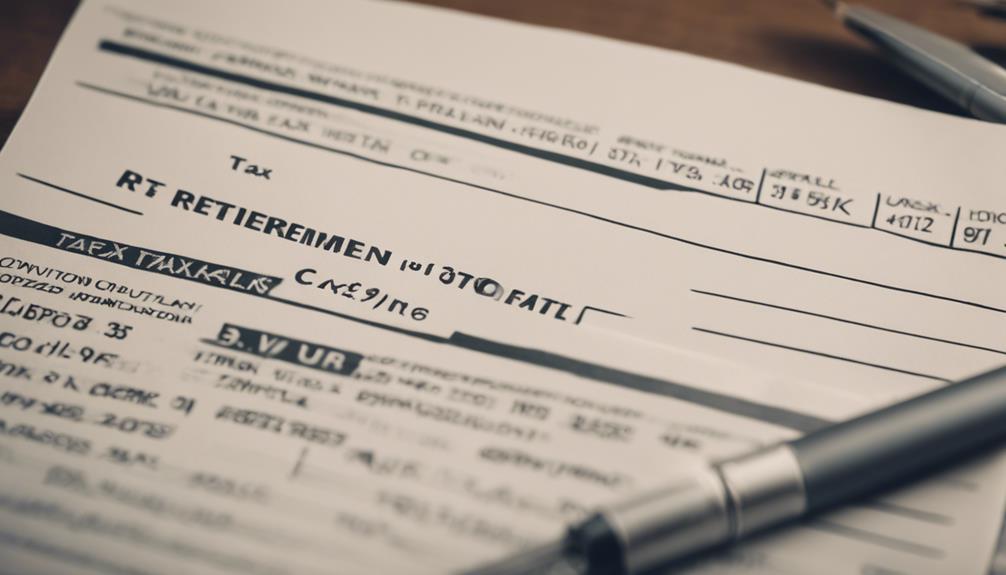Saving money in a retirement plan can have a positive impact on your tax return by lowering your taxable income. This reduction may result in benefits such as a decrease in tax liability and the opportunity to qualify for tax credits. Additionally, your contributions could potentially lower your tax bracket, providing both immediate and long-term tax advantages. By familiarizing yourself with the deductions and contributions related to retirement plans, you can optimize your tax position. These steps not only influence your current tax return but also have implications for your financial future. Being knowledgeable about this subject can assist you in making informed decisions regarding your retirement savings and tax planning.
Key Takeaways
- Retirement contributions lower taxable income.
- Tax deductions reduce overall tax liability.
- Potential for credits and deductions.
- Adjusted gross income may decrease.
- Strategic contributions optimize tax benefits.
Tax Deductions on Retirement Contributions

When calculating your tax return, you can benefit from tax deductions on your retirement contributions to traditional plans like IRAs and 401(k)s. These deductions work by reducing your taxable income, ultimately lowering the amount of taxes you owe. The IRS sets deduction limits for retirement contributions each year, taking into account factors such as your age, income, and the type of plan you have. Utilizing tax software can help you determine the maximum allowable contribution you can deduct on your tax return.
If you have an employer-sponsored retirement plan, like a 401(k), the contributions made to this plan are typically already reflected on your Form W-2. This means that you usually don't need to claim an additional deduction on your tax return for these contributions. Staying informed about the deduction limits and rules surrounding retirement contributions is crucial, as they can play a significant role in maximizing your tax benefits while saving for the future.
Impact on Taxable Income

Contributing to a retirement plan can impact your taxable income to a great extent. By lowering your taxable income through contributions, you may find yourself in a lower tax bracket.
This can result in a reduced tax liability and potentially lead to a lower adjusted gross income on your tax return.
Tax Bracket Effects
Lowering your taxable income through contributions to a retirement plan can have a significant impact on the tax bracket you fall into, potentially reducing the amount of tax you owe. By reducing your taxable income with retirement plan contributions, you may move into a lower tax bracket, resulting in tax savings.
This reduction in taxable income not only lowers the amount subject to taxation but also opens up the possibility of eligibility for tax credits and deductions. As your taxable income decreases due to contributions to retirement plans like a 401(k), you could benefit from reduced tax liabilities.
Hence, strategically utilizing retirement savings to lower taxable income can lead to significant financial advantages by minimizing the taxes you owe.
Adjusted Gross Income
Reducing your Adjusted Gross Income through contributions to retirement plans like a 401(k) or IRA directly impacts your taxable income, potentially leading to lower tax liabilities and eligibility for tax credits or deductions. Lowering your AGI by maximizing retirement contributions might even shift you into a lower tax bracket, saving you more money on taxes. This reduction in AGI is essential because it serves as the foundation for calculating your overall tax bill. By prioritizing contributions to retirement accounts, you not only secure your financial future but also reap immediate benefits by decreasing your taxable income. Making the most of these retirement savings opportunities can have a significant impact on the amount you owe in taxes and the potential refunds or credits you may receive.
| Benefits of Lower AGI | |||
|---|---|---|---|
| Moves you into a lower tax bracket | Makes you eligible for tax credits or deductions | Reduces your overall tax liability | Allows for maximizing contributions to retirement plans |
Benefits of Savers Tax Credit

To maximize the benefits of the Savers Tax Credit, make sure you meet the income limits and accurately report your eligible retirement contributions on Form 1040.
The Savers Credit offers a dollar-for-dollar reduction in taxes owed based on these contributions to various retirement accounts, such as employer-sponsored plans, traditional and Roth IRAs, and ABLE accounts. This credit can be as much as 50% of your contributions, providing significant tax benefits. Lowering your adjusted gross income (AGI) can lead to a higher Savers Credit amount.
To qualify, individuals must adhere to specific income limits, complete Form 8880, and correctly report the credit on Form 1040. By following these steps, you can take advantage of the Savers Tax Credit and enjoy the benefits it offers in reducing your tax liability while incentivizing your retirement savings.
Reduction in Tax Liability

Contributing to retirement plans such as a 401(k) or IRA can reduce your taxable income, ultimately lowering your overall tax liability.
By making pre-tax contributions to these accounts, you can decrease the amount of income subject to taxation in the current year.
This may lead to a higher potential for a tax refund, providing you with more financial security in the long run.
Tax Deduction Benefits
Lowering your taxable income through contributions to traditional IRA and 401(k) plans can result in a reduction in your overall tax liability. By taking advantage of tax deductions for retirement plans, you can reduce your taxable income, potentially leading to lower tax liability and increased tax savings.
Contributing to IRA and 401(k) accounts allows you to save for retirement while benefiting from immediate tax advantages. The more you contribute to eligible retirement accounts, the greater the reduction in your tax liability may be.
Utilizing these tax deduction benefits can have a significant impact on the amount you owe in taxes each year, providing you with an opportunity to save more for the future while lowering your current tax burden.
Lower Taxable Income
Reducing your taxable income through contributions to a retirement plan results in a decrease in your overall tax liability. By lowering the amount of income subject to taxation through retirement account contributions, you can reduce the amount of income tax you owe.
This reduction in taxable income directly translates to tax savings, as your tax liability is based on a lower amount of income. Making pre-tax contributions to a retirement plan allows you to immediately benefit from these tax savings, enabling you to keep more of your earnings.
Ultimately, lowering your taxable income through retirement savings can help you manage your tax burden effectively and save for the future with the potential for increased financial security.
Higher Refund Potential
Boosting your tax refund potential through contributions to retirement plans is a smart financial move that can result in significant savings. By reducing your taxable income with contributions to retirement accounts, you can potentially increase the amount of your refund. Lowering your taxable income due to retirement contributions directly impacts your overall tax liability, making it more likely for you to receive a refund.
Here are some key benefits of maximizing contributions to retirement accounts:
- Decrease the amount of taxes you owe
- Leverage tax benefits to increase your refund amount
- Immediate tax savings while saving for the future
Timing of Withdrawals for Tax Savings

Strategically timing your withdrawals from retirement accounts can maximize tax savings and help you avoid penalties. By waiting to withdraw funds until you reach retirement age, typically after 59 1/2, you may benefit from lower tax rates, resulting in reduced taxes on your withdrawals. This strategic timing can lead to significant tax savings compared to withdrawing funds early when penalties and higher tax rates may apply.
Additionally, being mindful of required minimum distributions, which usually start at age 72, is essential as they impact your taxable income. Failing to withdraw the required amount can lead to penalties, making it important to stay informed about these distribution rules to avoid unnecessary financial setbacks.
Roth Retirement Plans Tax Implications

When contemplating Roth retirement plans, it's important to grasp their tax implications for your future financial strategy. Contributions to Roth plans, such as Roth IRAs and Roth 401(k)s, are made with after-tax money, meaning they don't lower your taxable income in the year you contribute.
However, qualified withdrawals from Roth retirement plans are tax-free, including both your contributions and any earnings, under specific conditions. Here are some key points to ponder:
- Tax-Free Withdrawals: Qualified withdrawals from Roth retirement plans are tax-free, offering a significant advantage for your retirement income.
- Taxable Income Impact: Roth contributions don't reduce your taxable income initially, but they can provide tax benefits in the long run.
- Tax Bracket Consideration: Roth plans are beneficial if you anticipate being in a higher tax bracket during retirement, as you pay taxes on contributions upfront.
Roth retirement plans offer flexibility and potential tax advantages, making them a valuable tool for managing your tax liability in retirement.
Investment and Self-Employment Tax Strategies

Understanding how your investments and self-employment status can influence your tax strategies is pivotal for optimizing your financial future. By contributing to a retirement plan such as a 401(k), you can reduce your taxable income, potentially lowering your tax bill.
Self-employed individuals have the opportunity to benefit from tax-deferred retirement accounts like SEP-IRAs or Solo 401(k)s, allowing them to save for retirement while taking advantage of tax breaks. The investment earnings within these retirement accounts grow tax-deferred until you withdraw them during retirement.
Additionally, employer contributions to retirement plans aren't taxed until withdrawal, providing further tax benefits. Maximizing contributions to these individual retirement accounts can lead to long-term tax savings and financial security.
Adjusting Contributions Based on Tax Bracket

To optimize your tax savings, contemplate adjusting your retirement plan contributions based on your current tax bracket. Understanding where you fall in the tax bracket can help you make the most of your contributions. Here are some strategies to ponder:
- Pre-tax contributions: If you find yourself in a higher tax bracket, making pre-tax contributions can help lower your taxable income, resulting in immediate tax savings.
- Roth contributions: On the other hand, if you're in a lower tax bracket, Roth contributions may be more beneficial. While you won't get a tax break now, you can enjoy tax-free withdrawals in retirement, potentially saving you money in the long run.
- Consult a tax professional: It's always a good idea to seek advice from a tax professional when deciding on your retirement plan contributions. They can help tailor a strategy that aligns with your specific tax situation, ensuring you make the most tax-efficient choices.
Maximizing Retirement Contributions

Consider maximizing your retirement contributions to take full advantage of tax benefits and reduce your taxable income. By contributing the maximum allowed amount to retirement plans such as 401(k), 403(b), and IRAs, you can lower your current year's income tax liability. Opting for pretax contributions in these retirement plans enables you to maximize tax savings while building a secure financial future.
Employer-sponsored retirement plans also provide a valuable opportunity to save for retirement while simultaneously decreasing your taxable income. Additionally, exploring after-tax annuities can be a strategic way to supplement your retirement savings strategy. These contributions not only help secure your financial future but also offer immediate tax benefits by reducing your taxable income.
Frequently Asked Questions
Does a Retirement Plan Affect Your Tax Return?
When you contribute to a retirement plan, it can have a significant impact on your tax return. By reducing your taxable income through contributions, you may lower your tax liability.
This means you could potentially pay less in taxes, leading to tax savings. Understanding how these contributions affect your tax situation is essential for making informed financial decisions and maximizing your savings for retirement.
Do You Get a Tax Break on Saving for Retirement?
When saving for retirement, you benefit from a tax break by lowering your taxable income. By contributing to traditional accounts like IRAs and 401(k)s, you reduce your tax burden now. With Roth IRAs, you enjoy tax-free withdrawals in retirement after making contributions post-tax.
Employer-sponsored plans also offer tax advantages through decreased taxable income. Maximizing retirement contributions not only saves on taxes but also secures financial stability for the future.
Do You Report a Retirement Savings Plan on Taxes?
When reporting a retirement savings plan on taxes, keep in mind that contributions to plans like 401(k) or IRA are typically not directly reported on your tax return. These contributions are deducted from your taxable income, reducing the amount subject to taxes.
While your employer may list your contributions on your W-2, you generally don't need to separately report them. Accurate reporting guarantees you receive any eligible tax benefits.
Consult a tax professional for guidance on maximizing these benefits.
Does Retirement Savings Reduce Taxable Income?
Contributing to retirement savings does indeed reduce your taxable income. By putting money into a retirement plan like a 401(k), you lower the amount of income that's subject to taxation.
This means that the portion of your earnings that can be taxed is reduced, potentially leading to tax savings. It's a smart way to save for the future while also getting immediate tax benefits.
Conclusion
By saving in a retirement plan, you can potentially lower your taxable income, qualify for tax deductions, and even receive a Savers Tax Credit.
It's important to understand the tax implications of different retirement plans and adjust contributions based on your tax bracket.
Consider the timing of withdrawals and explore investment strategies to maximize your savings.
With careful planning and smart decisions, you can take advantage of tax benefits while preparing for a secure financial future.









